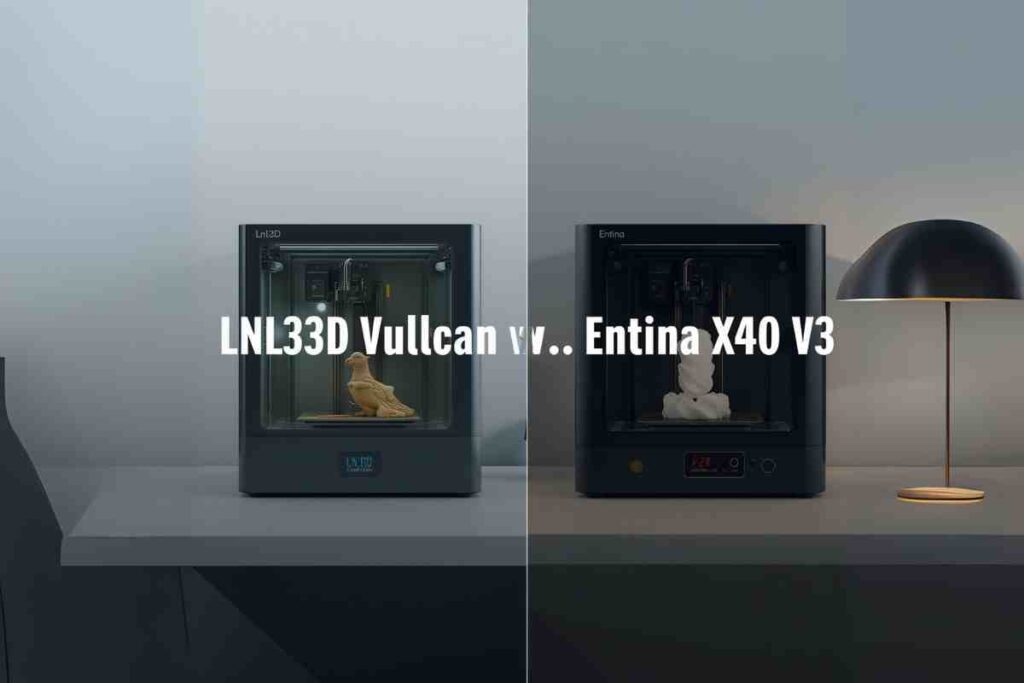The world of 3D printing has evolved rapidly in recent years, especially with the rise of Independent Dual Extruder (IDEX) technology. This innovation allows creators to print in multiple materials or colors at the same time, opening the door to more advanced projects.
Two popular IDEX printers often compared are the LNL3D Vulcan vs Entina X40 V3. Both deliver impressive performance, but they target slightly different users.
Understanding their strengths and trade offs can help you make the right choice for your needs.
LNL3D Vulcan – The Performance-Focused Workhorse
The LNL3D Vulcan is built for users who value control, customization, and consistent print quality. Many users report that it feels like a fine-tuned upgrade over other models in its class, with thoughtful improvements that benefit both hobbyists and small production setups.
Key Features
- IDEX System – Supports multi-material printing, duplication mode, and mirror mode.
- Direct Drive BMG-Type Extruder – Excellent for flexible filaments and precise extrusion control.
- 300°C Nozzle Temperature – Handles a wide range of high-performance filaments like nylon, PETG, and polycarbonate.
- Enhanced Bed Heating – Edge-to-edge insulation helps reduce heating time and prevent warping.
- Dual Cooling Fans – Promotes better overhangs and bridging performance.
- Magnetic PEI Build Plate – Dual-sided surface for smooth or textured finishes.
- Marlin 2 Firmware – Offers manual mesh bed leveling with advanced tuning options.
Pros
- Highly customizable firmware settings.
- Great for experienced makers who want detailed control.
- Reliable with high-temperature materials.
- Maintenance-friendly with removable extruder covers.
Potential Considerations
- Manual bed leveling requires some user skill.
- May involve more setup and calibration time compared to beginner-oriented printers.
Entina X40 V3 – The Smart, User-Friendly Option
The Entina X40 V3 focuses on making the printing process simple and accessible. Many users appreciate its automation features, smart connectivity, and quiet operation, making it a strong choice for those who want minimal setup time.
Key Features
- IDEX Printing – Offers the same dual-material capabilities as the Vulcan.
- Large Build Volume – 300 × 300 × 400 mm with extra Z-axis height.
- Auto-Leveling System – Automatically adjusts for bed inconsistencies, saving time and effort.
- 295°C Nozzle – Compatible with a broad range of filaments, including TPU and ABS.
- Silent Motherboard – Operates below 50dB with TMC2208 drivers.
- Wi-Fi Printing and Built-In Camera – Allows remote monitoring and control via a dedicated app.
- PEI Magnetic Platform – Ensures strong adhesion and easy part removal.
Pros
- Very beginner-friendly thanks to auto-leveling.
- Remote access and monitoring add convenience.
- Quiet operation suitable for home or office use.
- Larger vertical print capacity.
Potential Considerations
- Slightly less open to advanced firmware customization.
- Some advanced features may be underutilized by complete novices.
Side-by-Side Feature Comparison
| Feature | LNL3D Vulcan | Entina X40 V3 |
|---|---|---|
| Extruder System | IDEX Direct Drive | IDEX Direct Drive |
| Max Nozzle Temp | 300°C | 295°C |
| Build Volume | 300 × 300 × 350 mm | 300 × 300 × 400 mm |
| Bed Leveling | Manual Mesh | Auto-Leveling |
| Firmware | Marlin 2 | Proprietary with smart features |
| Connectivity | USB, SD card | USB, Wi-Fi, App |
| Monitoring | N/A | Built-in Camera |
| Noise Level | Moderate | Quiet (<50dB) |
Real-World Performance – Print Quality, Speed & Reliability
In practice, both printers are capable of producing professional grade prints, but the experience differs.
The Vulcan excels in precision and consistency when dialed in. A reliable method is to fine-tune print profiles and use quality filaments for optimal results. The robust heating system makes it ideal for large, warp prone models.
The X40 V3 shines in convenience. Many users report smooth first prints straight out of the box, with the auto-leveling and Wi-Fi monitoring reducing hands-on time. While it may not offer the same granular control as the Vulcan, it delivers solid quality with minimal effort.
Which Printer Should You Choose? (Buying Advice)
Choose the LNL3D Vulcan if:
- You enjoy fine-tuning and customizing printer settings.
- You often print with high-temperature or specialty materials.
- You prefer hardware with strong upgrade potential.
Choose the Entina X40 V3 if:
- You want an easy setup with minimal manual calibration.
- Remote monitoring is important to your workflow.
- You value quiet operation and a taller build space.
Final Verdict – Our Recommendation
Both models are capable IDEX 3D printers, but they serve different priorities. The Vulcan is best for technically inclined users who want maximum control and flexibility.
The X40 V3 is ideal for beginners or anyone seeking a more automated, plug-and-play experience.
Your choice should reflect your technical comfort level, the materials you plan to use, and how much you value convenience versus customization.
FAQs
Does the LNL3D Vulcan have auto bed leveling?
The LNL3D Vulcan comes with manual mesh bed leveling by default. However, it supports upgrades like BL-Touch sensors for automatic leveling if desired.
Which printer has the larger build volume?
The Entina X40 V3 offers a slightly taller build volume at 300 × 300 × 400 mm, compared to the Vulcan’s 300 × 300 × 350 mm.
Can both printers handle flexible filaments?
Yes. Both use direct drive extruders, which are well-suited for flexible materials like TPU. Proper temperature and speed settings will ensure the best results.
Is Wi-Fi printing available on both models?
Wi-Fi printing is built into the Entina X40 V3, complete with a monitoring camera. The Vulcan does not have this feature out of the box, but it can be added through mods.
Which is better for printing high-temperature materials?
The LNL3D Vulcan, with its 300°C nozzle and optimized heating, is slightly better suited for high-performance filaments like nylon and polycarbonate.





